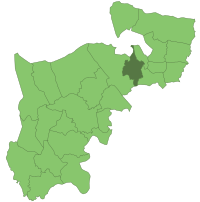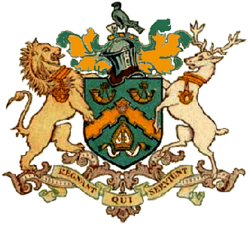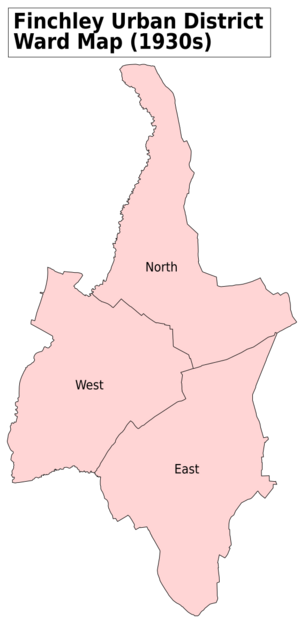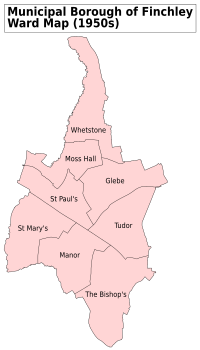Municipal Borough of Finchley facts for kids
| Finchley | |
| Motto: Regnant Qui Serviunt (They rule who serve) | |
 Finchley within Middlesex in 1961 |
|
| Geography | |
| Status | Local Government District (1878-1895) Urban district (1895 - 1933) Municipal borough (1933 - 1965) |
| 1901 area | 3,384 acres (13.7 km2) |
| 1961 area | 3,477 acres (14.1 km2) |
| HQ | Finchley |
| History | |
| Created | 1878 |
| Abolished | 1965 |
| Succeeded by | London Borough of Barnet |
Quick facts for kids Demography |
|
|---|---|
| 1901 population | 22,126 |
| 1961 population | 69,370 |
| Politics | |
| Governance | Finchley Local Board Finchley Urban District Council Finchley Borough Council |
 Coat of arms of Finchley Borough Council |
|
Finchley is a place in north London, England. For many years, from 1878 to 1965, it had its own local government. This meant Finchley made its own decisions about local services. It started as the Finchley Local Board in 1878. Later, it became the Finchley Urban District Council in 1895, and then the Municipal Borough of Finchley in 1933. In 1965, Finchley joined with other areas to form the London Borough of Barnet.
Contents
How Finchley's Local Government Started
Before the 1800s, Finchley didn't have a modern local government. In the mid-1800s, a law called the Local Government Act 1858 allowed towns to create a "local board" to manage their own affairs. Finchley first said no to this idea because they worried about the cost.
Because Finchley didn't form its own board, it was grouped with other areas under the control of the Barnet Rural Sanitary Authority in 1873. People in Finchley worried they would lose control over their own area to Barnet. This fear made them decide to adopt the 1858 law.
Forming the Local Board
The Finchley Local Board was created in 1878. It had twelve members who made decisions for the area. There were some disagreements between people from North Finchley and the wealthier Church End area. This was because people who owned more property had more votes under the old voting system. A plan to join with the nearby Friern Barnet area in 1881 did not happen.
Becoming an Urban District
A new law in 1894 changed how local governments were set up. Finchley Local Board became the Finchley Urban District Council in 1895. The council still had twelve members, and the disagreements continued. To help solve this, the area was divided into three sections, called wards, in 1898. These wards were East, North, and West. Each ward elected four councillors to represent them.
Finchley Becomes a Borough
In 1926, people in Finchley started thinking about becoming a "municipal borough." This would give Finchley more power and control. They were worried that their area might be taken over by the County of London or lose power to Middlesex County Council.
Finchley officially asked to become a borough in March 1932. Their request was approved. On October 5, 1933, Finchley officially became a municipal borough. The Earl of Athlone presented the special document, called a charter, to the first Mayor, Councillor Vyvyan Wells.
How the Borough Council Worked
The new town council had a mayor, six aldermen, and eighteen councillors. Councillors were elected every year, and aldermen were chosen by the council every three years. In 1950, the council grew bigger. It then had 24 councillors and eight aldermen. Each of the eight wards (Glebe, Manor, Moss Hall, St Mary's, St Paul's, The Bishop's, Tudor, and Whetstone) had three councillors and one alderman.
The Finchley Lido, a swimming pool complex, was built. There were also plans for a new town hall in 1936, but it was never built.
Finchley's Coat of Arms
When Finchley became a borough, it was given its own special coat of arms. This happened on July 10, 1933. The coat of arms had symbols that told a story about Finchley:
- The green background and "raguly" chevron (a zigzag shape with rough edges) showed the old oak woods that used to cover Finchley.
- Hunting horns and a Tudor Rose represented that the area was a favorite hunting spot for Tudor kings and queens.
- A bishop's mitre (a special hat) showed that much of Finchley once belonged to the Bishops of London.
- The top part of the arms had a finch bird holding a shield with a fleur-de-lis. This was a clever way to show the name "Finchley."
- One side of the shield had a lion, from the arms of the Countess of Pembroke, whose family owned land in Finchley.
- The other side had a stag, which also referred to the old forest.
The End of the Borough
In 1963, a new law called the London Government Act 1963 changed how London was governed. Because of this law, the Municipal Borough of Finchley was ended. On April 1, 1965, Finchley joined with other nearby areas like Hendon, Barnet, East Barnet, and Friern Barnet. Together, they formed the new London Borough of Barnet.
Twin Towns
The Borough of Finchley had four twin towns. These are towns in other countries that share friendly connections. The London Borough of Barnet still keeps these links today:
- Jinja, Uganda, since 1963
- Le Raincy, France, since 1962
- Montclair, New Jersey, United States, since 1945
- Siegen-Wittgenstein, Germany, since 1951
See also



